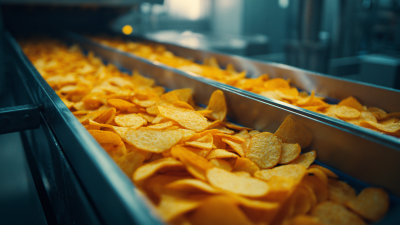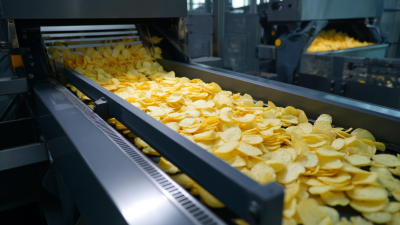Maximizing Efficiency: Innovative Insights into Modern Frying Production Line Techniques
Table of Contents
- Innovative Technologies Revolutionizing Frying Production Lines
- Understanding the Role of Automation in Modern Frying Processes
- Enhancing Product Quality: New Standards in Frying Techniques
- Sustainability Practices in Frying Production: A Path Forward
- Optimizing Energy Consumption in Frying Operations
- Integrating Data Analytics for Continuous Improvement in Frying Lines
- FAQS
- Conclusion
- Related Posts
The food processing industry is changing pretty fast these days, especially when it comes to frying production lines—that's really where a lot of the action is. I recently read a report from Grand View Research, and it said that the global market for fryers is projected to hit around 5.9 billion USD by 2025. A big reason for that? Folks are craving more convenience foods, plus there are some pretty cool innovations happening in frying tech. Companies like Shandong Kexinde Machinery Technology Co., Ltd.—they’re a major player in designing and making all sorts of food machinery—are really positioned to take advantage of these trends. By bringing some fresh, innovative techniques into their frying lines, businesses can boost efficiency, cut down on costs, and improve the quality of their products. Anyway, this article is all about sharing the latest insights and strategies in frying production systems. Hopefully, it’ll give industry folks like you the know-how to stay ahead in this pretty competitive market.

Innovative Technologies Revolutionizing Frying Production Lines
Modern frying lines are really going through some exciting changes thanks to new tech that makes everything more efficient and precise. One of the coolest upgrades is the addition of advanced oil recovery systems and smarter measurement tools, which help keep the frying process consistent and cut down on waste. This not only makes fried foods taste better and have better texture, but it also makes the whole operation more eco-friendly.
On top of that, smart kitchen tech is totally changing the game in professional kitchens. Automated systems are cutting down on labor costs and boosting productivity, so chefs can spend more time being creative instead of stuck doing the same boring tasks over and over. As these innovations keep gaining ground, it’s pretty clear that the future of frying production looks bright, with all these new features making it easier to meet the growing demand for top-quality fried foods.
Understanding the Role of Automation in Modern Frying Processes
Automation really has become a game-changer in how we do frying these days. Instead of sticking to the old-school methods, lots of manufacturers are turning to high-tech solutions like robotics and machine learning to streamline everything. It’s pretty amazing—these systems cut down on labor costs and crank up production speed at the same time. Plus, they let us control the temperature and timing with super-precision, which means the final product keeps that consistent quality we all want. Not only does this boost efficiency, but it also helps cut down on waste and saves energy, making the whole process a bit greener.
And here’s the cool part—automation isn’t just about speeding things up. It also keeps an eye on everything in real-time, providing data that lets you make quick adjustments or catch problems early before they turn into costly breakdowns or defective products. As more companies start adopting this tech, they’re better equipped to meet market demands and stay ahead of the competition. The machines communicate smoothly, creating an ideal environment for production, where humans can focus more on planning and strategy instead of juggling routine tasks. So yeah, automation is really transforming the frying industry—making it more efficient, smarter, and more sustainable than ever before.
Enhancing Product Quality: New Standards in Frying Techniques
In today’s super busy food world, finding ways to boost product quality through cool, innovative frying techniques is kinda essential if you want happy customers and to stay ahead of the competition. You know, modern methods like vacuum frying and using special oil filtration systems haven't just made fried foods taste better and have a better texture, but they also cut down on unhealthy fats quite a bit. I read a report recently from the Food Technology Association that says using these advanced frying methods can actually cut oil absorption by up to 30%. That means you get healthier snacks without sacrificing flavor—pretty awesome, right?
If you’re serious about stepping up your game, it’s worth investing in high-efficiency frying equipment that lets you control the temperature just right. Regular maintenance and good oil filtration can also help your frying oil last longer, so your products stay consistent, and you save some money too.
Safety and quality standards are becoming super important these days. The Global Food Safety Initiative (GFSI) stresses that frying needs to involve tight monitoring and control to avoid any contamination issues. Using automated frying systems with real-time data analytics not only helps ensure top quality but also keeps you compliant with the rules and meets what consumers expect.
A little tip—training your staff regularly on the latest frying techniques and safety protocols can really level up your production line. It helps maintain high standards, improves the overall product, and cuts down on waste. So, all in all, keeping up with these new tech and safety trends can seriously make a difference in your food game.
Maximizing Efficiency: Innovative Insights into Modern Frying Production Line Techniques - Enhancing Product Quality: New Standards in Frying Techniques
| Technique | Efficiency (%) | Oil Reduction (%) | Product Quality Score (1-100) | Standard Compliance (%) |
|---|---|---|---|---|
| High-Pressure Frying | 90 | 30 | 95 | 98 |
| Vacuum Frying | 85 | 40 | 90 | 95 |
| Continuous Frying | 92 | 25 | 88 | 97 |
| Infrared Frying | 80 | 35 | 85 | 90 |
| Batch Frying | 78 | 15 | 80 | 85 |
Sustainability Practices in Frying Production: A Path Forward
You know, when it comes to frying in the food industry, thinking about sustainability is more important than ever. It’s pretty clear that by adopting eco-friendly frying practices, companies can cut down on their carbon footprint and produce way less waste. One smart move is to switch over to energy-efficient fryers that have all these fancy heat recovery systems—they’re not just saving energy, but they also help fry oils last longer. That means you don’t have to change the oil as often, which cuts down on waste and disposal headaches.
Plus, using natural and organic oils—like plant-based ones that are sourced responsibly—can really make a difference. Not only does this support local farmers, but it also lines up with what many folks are looking for nowadays: healthier, cleaner food. And here’s a neat trick—recycling used oil into biodiesel can close the loop and make the whole process more sustainable. When companies start focusing on these kinds of practices, their frying lines can become real models of efficiency and environmental care. It’s all about moving toward a greener, more responsible future for our food industry—pretty exciting, right?

Optimizing Energy Consumption in Frying Operations
In today's super competitive world of food production, finding ways to cut down energy use in frying processes isn't just about saving money—it’s also about being kinder to the environment. Modern frying lines have pretty clever strategies up their sleeves to use less energy without sacrificing the quality of the food. For example, using really good thermal insulation materials helps keep the heat inside the fryer, so it doesn’t waste energy trying to stay hot all the time. It’s like putting a cozy blanket around the fryer to keep the heat in where it belongs.
And then there’s the whole smart tech thing—frying systems now can be fitted with sensors and data analysis that monitor how much energy is being used in real-time. These tools can spot patterns, so they can tweak cooking times and temperatures on the fly, depending on what’s being cooked and how much. This kind of flexibility not only saves energy but also makes the whole process run smoother and more efficiently, which obviously helps cut costs. As companies get more conscious about their environmental footprint, investing in these fancy new tech pieces will be a big part of running a more sustainable and cost-effective frying operation. It’s all about working smarter, not harder.”
Maximizing Efficiency: Energy Consumption in Frying Operations
This bar chart displays the energy consumption of various frying methods measured in kilowatt-hours (kWh) per 100 kilograms of product. Electric fryers are shown to use the most energy, while air fryers exhibit the lowest energy consumption.
Integrating Data Analytics for Continuous Improvement in Frying Lines
You know, in today's frying production lines, adding data analytics into the mix is pretty much essential if you want to keep improving and stay efficient. With advanced data tools, manufacturers can actually monitor key performance indicators in real-time, which means they can tweak the frying process on the fly without any hassle. I came across a study in the *Journal of Food Engineering* that says operations using data-driven methods have boosted their efficiency by up to 20%. Not only does this cut down on waste, but it also lowers energy use—pretty impressive, right? These kinds of insights can really make a difference in the final product too, ensuring that fried foods hit that perfect texture and flavor everyone loves, all while meeting the ever-increasing demand for sustainability.
On top of that, bringing AI into the frying process can really level up consistency and safety. A review I read recently pointed out how AI can help fine-tune frying temps and times, which means fewer worries about undercooked or burnt items. Plus, integrating AI makes operations smoother overall and gives companies cool insights into customer preferences, so they can quickly adapt their menu or products based on what folks actually want. As the industry keeps changing, companies that jump on these data-tech bandwagons will definitely have a better shot at staying ahead in the game.

FAQS
: Innovations include advanced oil recovery systems and measurement units that optimize the frying process, improve flavor and texture, and contribute to sustainable production practices.
Automation reduces labor costs, increases throughput, ensures precise temperature control, and enhances operational efficiency, leading to consistent product quality and minimized waste.
Automated systems enable real-time monitoring, data analytics, timely adjustments, and predictive maintenance, helping to identify potential issues before they cause significant downtime or defects.
Techniques like vacuum frying and oil filtration reduce unhealthy fat content and oil absorption by up to 30%, improving the texture and flavor of fried products while maintaining a healthier profile.
Manufacturers should invest in high-efficiency frying equipment for precise temperature control and implement regular maintenance and oil filtration systems to prolong frying oil life and ensure consistent quality.
Adherence to standards like those from the Global Food Safety Initiative (GFSI) helps prevent contamination and ensures regulatory compliance, ultimately enhancing consumer trust and satisfaction.
Regular training on the latest frying techniques and safety protocols is essential for maintaining high standards throughout the production line, enhancing product quality, and reducing waste.
Data analytics in automated frying systems enhances quality assurance by providing real-time insights that help manufacturers meet regulatory compliance and consumer expectations.
The integration of smart kitchen technologies and automation is allowing for increased creativity in food preparation, minimizing labor tasks, and ultimately leading to a revolution in the frying industry.
Innovations such as advanced oil recovery systems and automation reduce waste and energy consumption, making frying processes more sustainable while maintaining product quality.
Conclusion
The article titled "Maximizing Efficiency: Innovative Insights into Modern Frying Production Line Techniques" dives into the game-changing technologies that are transforming how frying lines are operated in the food industry. Honestly, it really underlines how automation is becoming a key player in boosting efficiency and making sure modern frying methods meet new, higher quality standards. Plus, it touches on the growing importance of sustainability — like strategies to cut down energy use and use data analytics for ongoing improvements.
As a major player in the field, Shandong Kexinde Machinery Technology Co., Ltd. gets how critical these advancements are. They’re pushing to stay ahead of the curve, aiming to support the food and beverage sectors with innovative solutions while also championing environmentally friendly practices.
Related Posts
-

The Complete Guide to Sourcing the Best Onion Frying Machine for Your Business
-

5 Essential Tips for Optimizing Your Frying Production Line Efficiency
-

15 Best Practices for Maximizing Your Tempura Nugget Line Efficiency
-

How to Optimize Your Plantain Chips Frying Machine for Maximum Efficiency
-

The Future of Efficient Frozen French Fries Production Technology
-

Explore the Advanced Technical Specifications of the Best Fully Automatic Potato Chips Machine

